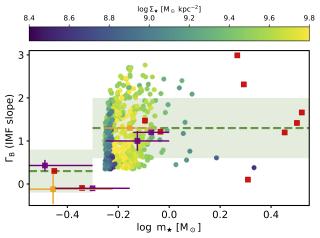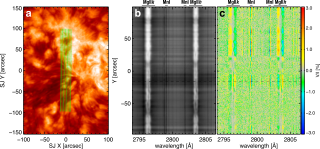We find a distinct stellar population in the counterrotating and kinematically decoupled core of the isolated massive elliptical galaxy NGC 1700. Coinciding with the edge of this core, we find a significant change in the slope of the gradient of various representative absorption line indices. Our age estimate for this core is markedly younger than the main body of the galaxy. We find lower values for the age, metallicity, and Mg/Fe abundance ratio in the center of this galaxy when we compare them with other isolated elliptical galaxies with similar velocity dispersion. We discuss the different possible scenarios that might have lead to the formation of this younger kinematically decoupled structure and conclude that, in light of our findings, the ingestion of a small stellar companion on a retrograde orbit is the most favored.
Advertised on
References
2011, ApJ, 732L, 33K
It may interest you
-
 Ultra-diffuse galaxies, an extreme type of dwarf galaxy, have been the focus of extensive observational and theoretical studies over the past decade. With stellar masses comparable to dwarf galaxies (between 10 7 and 10 9 solar masses) but much larger in size (as defined by their effective radius), they exhibit an extremely low surface brightness. These galaxies display highly diverse properties: some have large dark matter halos, others lack them, and their number of globular clusters varies widely. Studies of their kinematics and stellar populations have shown that these extreme galaxiesAdvertised on
Ultra-diffuse galaxies, an extreme type of dwarf galaxy, have been the focus of extensive observational and theoretical studies over the past decade. With stellar masses comparable to dwarf galaxies (between 10 7 and 10 9 solar masses) but much larger in size (as defined by their effective radius), they exhibit an extremely low surface brightness. These galaxies display highly diverse properties: some have large dark matter halos, others lack them, and their number of globular clusters varies widely. Studies of their kinematics and stellar populations have shown that these extreme galaxiesAdvertised on -
 The universality of the stellar initial mass function (IMF) is one of the most widespread assumptions in modern Astronomy and yet, it might be flawed. While observations in the Milky Way generally support an IMF that is invariant with respect to the local conditions under which stars form, measurements of massive early-type galaxies systematically point towards a non-universal IMF. To bridge the gap between both sets of evidence, in this work we measured for the first time the low-mass end of the IMF from the integrated spectra of a Milky Way-like galaxy, NGC3351. We found that the slope ofAdvertised on
The universality of the stellar initial mass function (IMF) is one of the most widespread assumptions in modern Astronomy and yet, it might be flawed. While observations in the Milky Way generally support an IMF that is invariant with respect to the local conditions under which stars form, measurements of massive early-type galaxies systematically point towards a non-universal IMF. To bridge the gap between both sets of evidence, in this work we measured for the first time the low-mass end of the IMF from the integrated spectra of a Milky Way-like galaxy, NGC3351. We found that the slope ofAdvertised on -
 The magnetic field in the solar chromosphere plays a key role in the heating of the outer solar atmosphere and in the build-up and sudden release of energy in solar flares. However, uncovering the magnetic field vector in the solar chromosphere is a difficult task because the magnetic field leaves its fingerprints in the very faint polarization of the light, which is far from easy to measure and interpret. We analyse the spectropolarimetric observations obtained with the Chromospheric Layer Spectropolarimeter on board a sounding rocket. This suborbital space experiment observed the nearAdvertised on
The magnetic field in the solar chromosphere plays a key role in the heating of the outer solar atmosphere and in the build-up and sudden release of energy in solar flares. However, uncovering the magnetic field vector in the solar chromosphere is a difficult task because the magnetic field leaves its fingerprints in the very faint polarization of the light, which is far from easy to measure and interpret. We analyse the spectropolarimetric observations obtained with the Chromospheric Layer Spectropolarimeter on board a sounding rocket. This suborbital space experiment observed the nearAdvertised on